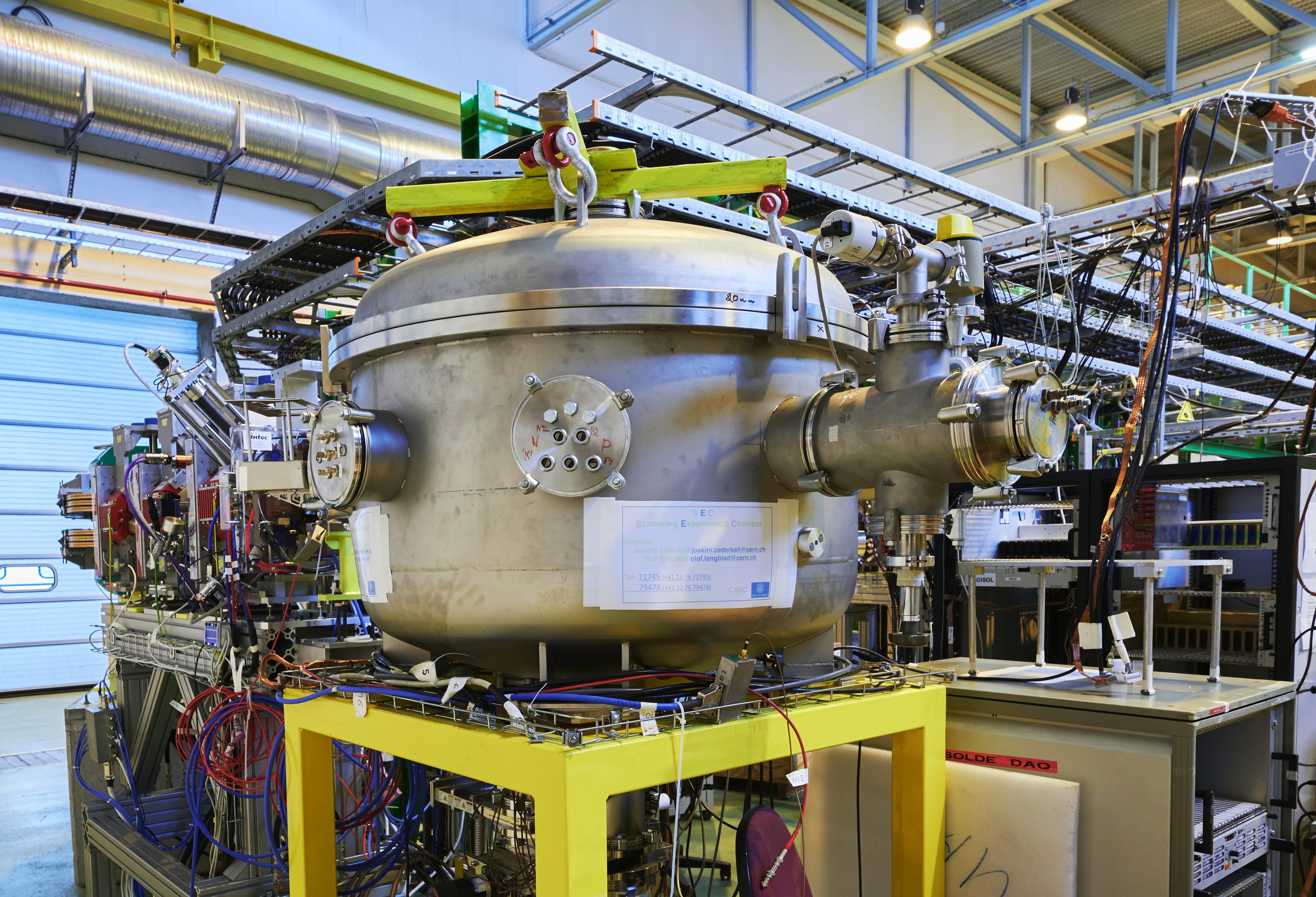
The Isotope Separator On-Line facility (ISOLDE) directs a proton beam from the Proton Synchrotron Booster (PSB) onto specially developed thick targets, producing low-energy beams of radioactive nuclei - those with too many or too few neutrons to be stable. These beams can be further accelerated to energies of up to 10 MeV per nucleon using the HIE-ISOLDE linear accelerator, enabling a wide range of studies. The HIE-ISOLDE beams are sent to three experimental stations: the Miniball array of high-purity germanium gamma-ray detectors, the ISOLDE solenoid spectrometer (ISS), which repurposed a former MRI magnet, and the scattering experimental chamber (SEC), used for a broad variety of physics experiments. Since its first experiment in October 2015, HIE-ISOLDE has been pushing back the boundaries of nuclear physics. To celebrate its 10th anniversary, we look back at ten key achievements that have defined its first decade.
The first HIE-ISOLDE experiment
The first experiment at HIE-ISOLDE, conducted in October 2015, accelerated a radioactive beam of neutron-rich zinc nuclei to 4 MeV per nucleon, using the new superconducting linear accelerator, and delivered it to the Miniball station. The beam's higher energy compared to that of REX-ISOLDE, the predecessor to HIE-ISOLDE, allowed researchers to study high-energy states of these nuclei in unprecedented detail and to compare the results with state-of-the-art theoretical models.
Proving tin's doubly magic status
By accelerating a beam of 132Sn nuclei with HIE-ISOLDE to an energy of 5.49 MeV per nucleon and impinging it on a lead target inside Miniball, researchers obtained the first direct proof that this tin nucleus is doubly magic - meaning its protons and neutrons fill shells to their maximum capacity, making the nucleus especially stable. The result was described in the first published paper using HIE-ISOLDE data, in 2018.
Radon's shape-shifting nuclei
Pear-shaped nuclei, such as certain nuclei of radon and radium, are crucial for testing nuclear theories and searching for physics beyond the Standard Model. In 2019, researchers reported a study using HIE-ISOLDE beams of 224Rn and 226Rn at Miniball that revealed that, unlike 224Ra, which was studied at the earlier accelerator REX-ISOLDE, these radon nuclei do not maintain static pear shapes in their ground states. Instead, they vibrate between a pear shape and its mirror image, offering less sensitivity in searching for new physics than 224Ra.

The ISS magnet: from MRI to nuclear physics
In 2016, a decommissioned MRI magnet travelled across the seas from Australia to CERN for a second life as the heart of the ISOLDE Solenoidal Spectrometer (ISS). ISS received its first beams in 2018 and was fully commissioned in 2021. Since then, it has studied 20 different nuclear species, from heavy nuclei like 212Rn to light ones such as 11Be, showcasing the wide range of nuclei available at ISOLDE.
Testing the r-process with mercury nuclei
In neutron-rich cosmic environments such as supernovae, nuclei can rapidly capture neutrons, forming heavier elements through the "r-process". Among the least explored nuclei that are crucial for understanding this process are nuclei with fewer than 82 protons and more than 126 neutrons. The first ISS experiment stepped into this almost uncharted territory by directing a HIE-ISOLDE beam of 206Hg nuclei (with an energy of 7.38 MeV per nucleon) onto a deuterium target, revealing events in which 206Hg captured a neutron and turned into 207Hg. The result, published in 2020, marked the first exploration of the neutron structure of 207Hg and enabled the testing of r-process models.
Unravelling the secrets of doubly magic tin
Tin stands out with its 50 protons (a magic number) and two doubly magic nuclei: 100Sn (50 protons, 50 neutrons) and 132Sn (50 protons, 82 neutrons). In 2024, researchers used a HIE-ISOLDE beam of 132Sn at ISS to probe the highest-energy states of this nucleus for the first time, thanks to the beam's high energy. The results provide long-sought-after information that allows the properties of large numbers of medium-mass nuclei to be calculated using nuclear models.

Investigating fission mechanisms
Using a 209Fr beam accelerated at HIE-ISOLDE, scientists investigated how easily the short-lived nuclei 210Fr and 210Ra, created in nucleon-transfer reactions, undergo fission. A sensitive set-up based on Timepix3 detectors enabled precise tracking of fast neutrons, revealing how the nuclei split at different energies. The first direct measurement of the fission barrier of 210Fr - the minimum amount of energy it must overcome to split - showed it to be 15-30% lower than predicted, offering an insight into how neutron-deficient radioactive nuclei fission.
Tackling the cosmic lithium puzzle
The "lithium problem" - a discrepancy between the observed amount of 7Li and that predicted by Big Bang nucleosynthesis models - has puzzled scientists for decades. Such primordial 7Li originates mainly from the decay of 7Be. Using a HIE-ISOLDE beam of 7Be at the SEC station, researchers investigated a potential 7Be destruction pathway, yielding new data to help to tackle the puzzle.
Exploring nuclear halos
Some nuclei have "halos" - loosely bound protons or neutrons orbiting far from the core. By scattering HIE-ISOLDE beams of two such nuclei - 8B and 15C - off heavy targets at SEC, researchers have shed new light on how these halos impact the nuclei's interactions in unexpected ways, clearly showing the effect of the extended structure of these special nuclei.
Studying rare decays
Even neutron-rich nuclei can decay via rare processes that lead to the emission of protons. This is the case of the neutron-rich halo nucleus 11Be, which can emit a proton after undergoing a type of radioactive decay called beta decay. In a HIE-ISOLDE experiment, hundreds of 11Be ions were implanted into an optical time projection chamber, a detector that is able to take "photographs" of individual decay events. By measuring the beta decays followed by the emission of charged particles, the experiment set a stringent limit on how often 11Be nuclei emit protons after beta decay, contradicting some previous results.







